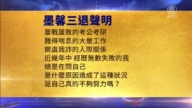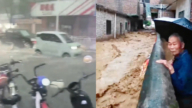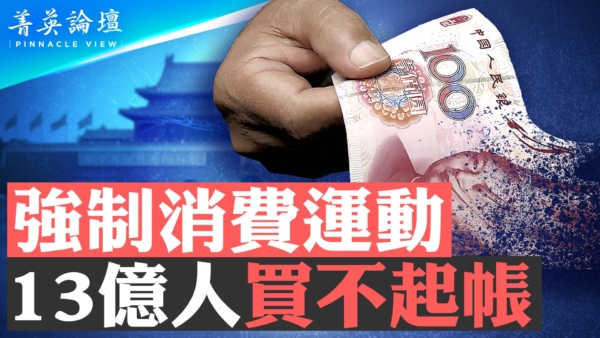【新唐人2013年10月30日訊】隨著近年來大陸各地拆遷重建規模的持續擴大,因此產生的建築垃圾也在日益增多,達到了每年15億噸以上。由於沒有有效的處理方法,隨意傾倒、堆積建築垃圾的現象極為嚴重,人們擔心繼續下去,城市遲早會被建築垃圾所吞噬。
如今在大陸,人們會發現一個非常普遍而怪異的現象,在一排排光鮮漂亮的建築四周,矗立的卻是一堆堆小山般的垃圾,而這些建築垃圾在城市的周邊、公路兩旁、橋下、河邊更加隨處可見。甚至在一些地區出現了「垃圾圍城」的場面。
四川南衝市民吳先生:「(建築垃圾)到處都是,一般在空地,未開發的、準備開發的樓盤。在小區裏面很多的,有私人的,還有那些公司的。那個沙土全部都堆在路邊了。」
令民眾不滿又無奈的是,這些建築垃圾長則幾年,少則幾個月、幾個星期的堆放,卻無人問津。有忍無可忍的市民打電話到當地政府,卻遭到各個部門的互相推諉。在網路搜索「建築垃圾誰管」,就會出現大量來自大陸各地民眾的投訴貼、和曝光貼、求助貼。
如此多的建築垃圾是怎麼產生的?據專家測算,每拆掉1平方米混凝土建築,就會產生近1噸的建築垃圾。而大陸近年來的「城市化大躍進」以及「大拆遷運動」,產生了數量驚人的建築垃圾。據工信部統計數據顯示﹕自2010年開始,中國每年產生的建築垃圾超過十億噸。去年則有15億噸。
與歐美國家不同的是,歐美國家將95%的建築垃圾進行回收再利用,而中國大陸絕大部分城市則選擇了「露天堆放」和「集中填埋」。這些做法簡單易行,卻佔用大量土地和污染環境。
其實,中國並不是沒有從事建築垃圾循環利用的企業,但是由於得不到政府的重視和政策上的有效支持,使得整個行業幾乎處於集體虧損狀態,僅有少數企業在勉力維持運營。
河南盛天環保再生資源利用有限公司 助理工程師 司先生:「比如說我們要上這個項目,要立項的話,政府應該給予一定的政策支持,比如說你去註冊啊,稅收這方面政府都應該給予支持。現在政府在這方面沒有明確的政策傾向。比如說省一些職能部門,比如說科技局啊,或者說發改委這些,他們只是更多的傾向於高新技術產業,對於環保產業他們傾向的力度並不夠。」
此外,河南「盛天環保再生資源利用有限公司」司姓助理工程師還告訴記者,用地得不到保障和原料供應不足,也是再生環保行業面臨的兩大難題。
司先生:「我們現在建立這個建築垃圾處理站,首先這個土地問題不好解決,一般情況這種屬於環保行業,一般土地撥付了吧應該,但是現在這種土地都是我們自己去找的,租賃這個土地價格特別昂貴,買更是買不起。」
據了解,由於政策上的漏洞,垃圾清運公司將垃圾送到回收處理企業,需要向城管部門繳納一筆費用,加上運輸費,花費遠遠高於隨意傾倒的成本,因此沒有垃圾清運公司願意把建築垃圾送往垃圾處理企業,而很多垃圾處理公司不得不花高價去購買垃圾。
司先生:「傳統的處理方式是甚麼?拿到郊區填埋,就隨便就堆了,現在很多這種建築垃圾大部分都是通過從市區拉出來之後,只要是空地他就亂倒,只要是個坑他就倒,只要是個溝他也倒,這種填埋他不需要掏錢啊!他們只圖運輸距離近,1他們之所以還是填埋,是因為政府沒有強制他們。」
在大陸,沒有明確法律規定如何處置建築垃圾,於是出現了一方面巨量的建築垃圾不斷產生,另一方面,建築垃圾處置企業求援無門。產業政策與監管的缺失,讓建築垃圾整個產業鏈亂象叢生。
採訪編輯/張天宇 後製/君卓
Recycling Businesses Are Facing Difficulties;
Construction Waste Is Covering up Cities
Recent demolition and reconstruction across China over the
years continues to expand in scale, resulting in increasing
construction waste of over 1.5 billion tons per year.
Since there are no effective treatments, random dumping and
accumulation of construction waste are extremely serious.
People are concerned that cities will be covered up
by construction waste sooner or later.
There is a very common yet strange phenomenon in China.
Mounds of construction garbage surround rows of buildings.
The waste is more obvious along cities peripheries, at
roadsides, under bridges and along the river.
Some cities are even surrounded by waste.
Sichuan Nanchong City resident Mr. Wu:"Construction waste
is everywhere, usually in open areas, undeveloped or to be
developed real estate sites.
There are lots of them in the neighborhoods.
Sand and dirt all piled up along the roadside."
It is frustrating that construction wastes could stay for
weeks, months and even years, without being cleaned up.
When citizens phone local government agencies,
officials just shift the responsibilities onto others.
Searching on the Internet for “construction waste cares,"
one can see a large number of complaints, exposure of issues
and asking for help from people all over China.
How was so much construction waste generated?
Experts estimate that demolition of every square meter of
concrete construction produces nearly one ton of waste.
China’s “Urbanization Great Leap Forward" and “Great
Demolition Movement" in recent years have generated a
surprising amount of construction waste.
According to the survey data by Ministry of Industry and
Information Technology, over one billion tons of construction
waste was generated annually since the beginning of 2010,
with 1.5 billion tons in 2012.
While Europe and the U.S. recycle 95 of construction waste,
most cities in China resort to “piling them up outside"
and “centralized landfill."
These practices are simple, but take up a lot of land and
pollute the environment.
In fact, China has construction waste recycling businesses.
Due to lack of government attention and effective support,
the whole industry is almost in a lost state.
Only a few companies are struggling to operate.
Henan Shengtian Environmental & Renewable Resource
Utilization Co Ltd (Shengtian) Assistant Engineer Mrs. Si:
“For example, the government should support in the aspects
of company registration and tax.
But the government does not have specific polices.
Provincial level agencies such as Science and Technology
Bureau or National Development and Reform Commission
(NDRC) only favor high-tech industry.
There is not enough attention on the environmental industry."
Mr. Si also told the reporter that the recycling business
is facing two big problems:
Lack of guarantee of use of land and inadequate supply
of raw materials.
Mr. Si: “The first problem we have in building
waste stations is land.
Land should be allocated to the environmental industry.
But we have to find land on our own.
It is extremely expensive to rent land.
We cannot afford to buy land. “
Due to policy loopholes, garbage removal companies need to
pay urban management to send waste to recycling.
With shipping charges added, costs of recycling are much
higher than random dumping.
Therefore no garbage removal company is willing to
send construction waste to waste disposal companies.
Many waste disposal companies pay a high price to buy waste.
Mr. Si: “In the past, waste was taken to the suburb and buried.
Now lots of construction waste is just dumped to empty spaces,
be it a hole or stream, as long as it is free.
They only care about the distance. The government does not
forbid them from doing so."
In China, there is no clear law on construction waste disposal.
While there is a huge amount of construction waste,
construction waste disposal companies do not get any help.
The lack of industrial policy and regulation have caused
chaos in the entire industry chain of construction waste.
NTD Reporter Zhang Tianyu




























